New Year's holiday traffic was light on Mississippi's I-10 when Chris Cason merged his F-250 into the slow lane. A brand-new Triton 2895 Center Console, rigged out with twin 250s, sat on the big Ford's hitch ball. The 7800-pound load didn't pose much of a strain on his pickup.
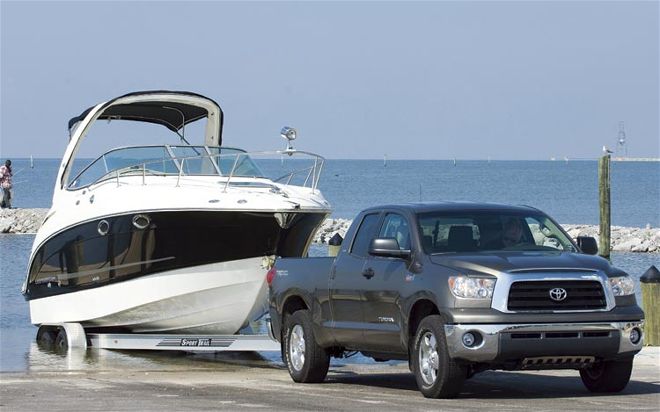
| towing 2007 Toyota Tundta With Boat
Cason called his customer, letting him know he was on the way with his new boat. Less than a minute after he finished the call, a big rig blew by in the center lane, then a second big rig came right behind the first.
The trailer behind Cason's truck started a death sway. Less than 30 seconds later, he was crawling out of his pickup on the shoulder while watching the dust settle around the boat, which had come to rest 50 yards away in the center median of the six-lane Interstate. He wasn't hurt, but the boat and trailer weren't as fortunate.
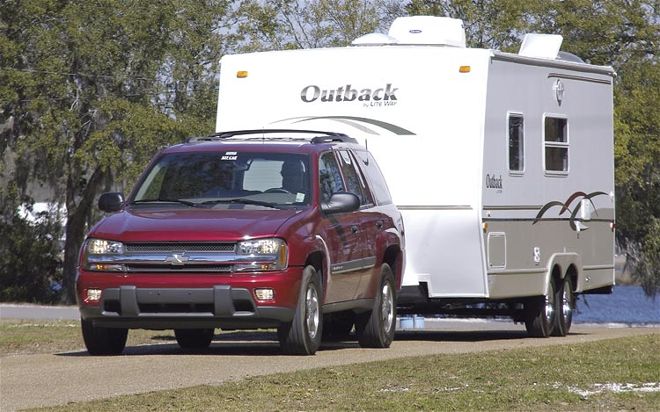
| This travel trailer is hooked to the factory receiver and drawbar--the tow vehicle needs a weight-distributing hitch to legally tow this weight travel trailer.
RISK TAKINGHe was lucky. If anyone had been hurt in the accident, there could have been a huge lawsuit: Cason was towing the big boat/trailer without a weight-distributing hitch, which is required by Ford on any trailer that weighs more than 5000 pounds. Cason risked being hit with all sorts of liability issues from personal to business because his tow vehicle wasn't "properly equipped." It's a lesson anyone who tows a trailer needs to take seriously.
Towing is a big part of our lives. We tow trailers for work--and for play. It's one of the main reasons we buy pickups and SUVs instead of cars.
That fact isn't lost on automotive manufacturers. Towing capacities are a huge sales tool, and today, when it comes to measuring the level of a pickup or SUV's performance, higher towing capacity numbers are touted more than horsepower.
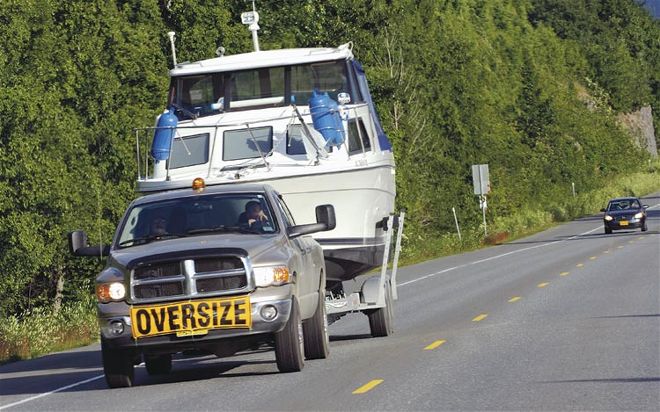
| Whatever size pickup or SUV you drive, the vehicle has to be properly equipped to tow legally. This driver has an overwide and overweight trailer in tow behind his Dodge Ram.
BIG LIABILITY ISSUEBut what's often left out of such sales messages are serious safety and liability issues equated to towing and tow ratings, which become the driver's responsibility the moment trailer is hitched to tow ball. To stay on the safe--and legal--side of towing, one only need answer "yes" to these three simple questions:
• Are your tow vehicle and hitch rated for the weight of the trailer in tow?
• Have you closely read the towing section of your vehicle's owner's manual?
• Are the tow vehicle and trailer properly equipped according to the owner's manual?
If the trailer in tow is heavier than the vehicle manufacturer's stated limit, and/or the tow vehicle isn't properly equipped to pull that weight of trailer, from a legal standpoint if any sort of accident happens, you're pretty much hung out to dry.
PROPERLY EQUIPPEDThe vehicle manufacturer has the final word on how much your vehicle can tow and how it must be equipped to do so. Period. Those limitations and requirements are clearly stated in the towing section of every owner's manual--and on the manufacturer's Web site.
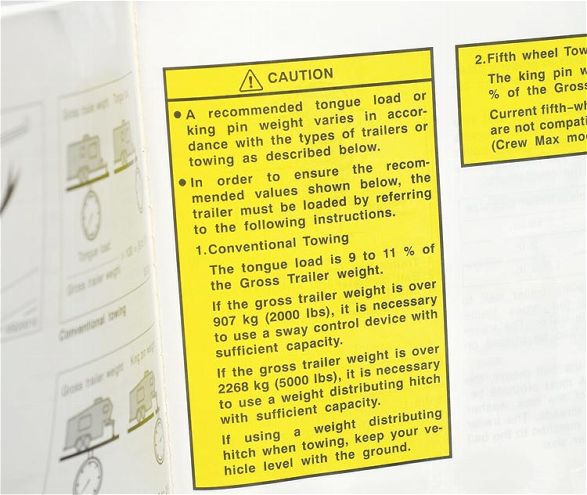
| towing PROPERLY EQUIPPED Manual
As an example, a 2008 Toyota Tundra Double Cab 4x4 is rated to tow a 10,300-pound trailer. But on page 487 of the owner's manual, it clearly states that any trailer weighing more than 2000 pounds requires the use of a sway-control device. For trailers weighing more than 5000 pounds, it's necessary to use a weight-distributing hitch of sufficient capacity.
Ford's F-250/350 Super Dutys require the use of a W-D hitch on trailers weighing more than 5000 pounds as well. Dodge, Chevrolet, GMC, and Nissan pickups and SUVs have similar towing caveats noted in the owner's manuals and on the factory Web sites related to tow ratings.
The reason for such devices is simple: A weight-distributing hitch maintains the vehicle's steering stability and body control when a heavy trailer tries to push the tow vehicle around during cornering, hard braking, through dips in the road, in windy conditions, or any time trailer sway might be induced.
SIMPLE ANSWERW-D hitches work fine on trailers with electric brakes. They don't fare as well on trailers with surge-type brakes, which are found on many boat, utility, and cargo trailers, and car haulers.
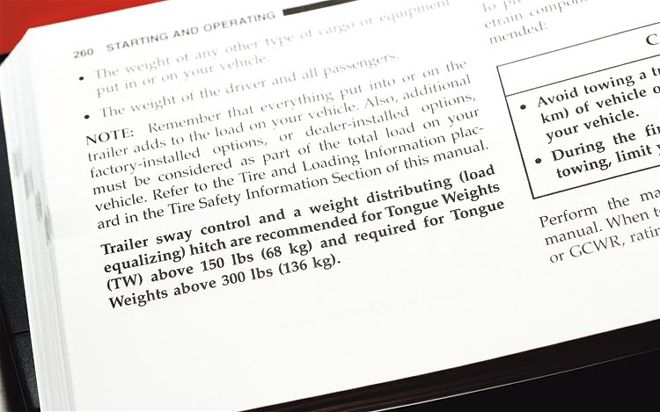
| Carefully read your vehicle's owner's manual before towing. It spells out what your vehicle needs to be properly equipped for towing trailers of various weights.
The problem is conventional weight-distributing hitches and sway-control devices interfere with the operation of such braking systems. (W-D hitches that use chains to adjust the bars that do the weight distributing don't always allow the coupler on the trailer to move freely to actuate the braking system.)
However, now there are two weight-distributing hitches designed to work with trailer surge-brake systems: the Equal-i-zer Sway Control Hitch (www.equalizerhitch.com; 800/478-5578) from Progress Manufacturing, and the new Reese SC (www.reeseprod.com; 734/656-3000) from Cequent Towing Products.
Reese's SC, the newest on the market, provides built-in friction sway control and a unique design that allows surge-brake systems to function properly. The kit retails for $560 and is available in 600-, 800-, 1200-, and 1500-pound tongue weight ratings.
ROAD-TEST EVALUATIONWe installed the Reese SC on a 2008 Toyota Tundra Double Cab 4x4 equipped with Toyota's towing package option. Our test unit was a 27-foot Chaparral cruiser on a tandem-axle trailer, with a towed weight of nearly 9200 pounds.
Without the W-D hitch in place, the Tundra squatted heavily at the rear and was unsettling to drive. That was expected. After all, we were testing with 4200 pounds more trailer weight and 400 pounds more tongue weight than Toyota recommends without weight distribution.
After installing the Reese SC W-D kit, we hit the road driving over railroad tracks, through harsh dips, over broken pavement, and on the Interstate so we could be passed by tractor-trailer rigs. We also tried inducing trailer sway by swerving sharply on a test track at speeds around 35 mph and did several panic stops from much higher speeds.
Our biggest surprise using the Reese SC was the Tundra actually handled and rode better with 4-1/2 tons in tow than it did unladen. It further demonstrated remarkable stability and control even during hard braking and our induced sway maneuvers.
SMART HITCH DESIGN"A weight-distributing hitch will do that," says Joe Riexinger, the Southern regional sales manager for the Cequent Towing Products group. "It transfers a lot of the tongue weight from the rear of the tow vehicle toward the front and the rear of the trailer. This levels out the tow vehicle and places more weight over the front tires for greater steering control."
"The Reese SC weight-distributing hitch also provides that sway control so the tow vehicle is much more stable when it goes through dips, over bumps, or is hit with sudden side winds like those caused by passing big rigs."
Once it's installed on the trailer and adjusted for your tow vehicle, it's no more complicated than towing on the ball. Just drop the trailer onto the W-D hitch, lift the spring bars into their brackets, make your normal trailer connections, and go.
Using a weight-distributing hitch such as the Reese SC or the Equal-i-zer means your tow vehicle/trailer combo is properly equipped, and the result is towing in a safe and predictable manner. Now there's no reason to tow a surge-brake-equipped trailer any other way.
SOURCES
Ocean Marine GroupGulfport, MS
228/822-2633
www.ocean-marine.comWeb Towing Sources
www.1800hitchit.com
www.4vehicleaccessories.com
www.877hitchit.com
www.bsaohio.com
www.cheaphitches.com
www.etrailer.com
www.hechttrailers.com
www.hitchesforless.com
www.hitchesonline.com/a>
www.hitchfinder.com
www.hitchmart.com
www.hitchsales.com
www.hitchshopusa.com
www.lam-part.com
www.olbeasthitch.com
www.quadratec.com
A CLOSER LOOKReese SC Weight-Distributing Hitch Kit
Reese's SC weight-distributing hitch kit is well designed and the installation instructions easy to follow. Install time is less than 30 minutes.
Common hand tools are all that are needed to install the Reese SC, shown here being installed on the pole tongue of our boat trailer.
The Equal-i-zer weight-distributing hitch uses brackets to allow the spring bars to slide, thus allowing the trailer's surge brakes to work properly.
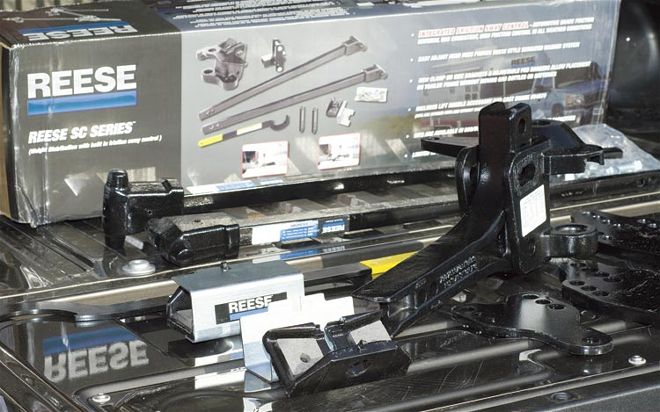
| towing reese SC Series Tow Kit
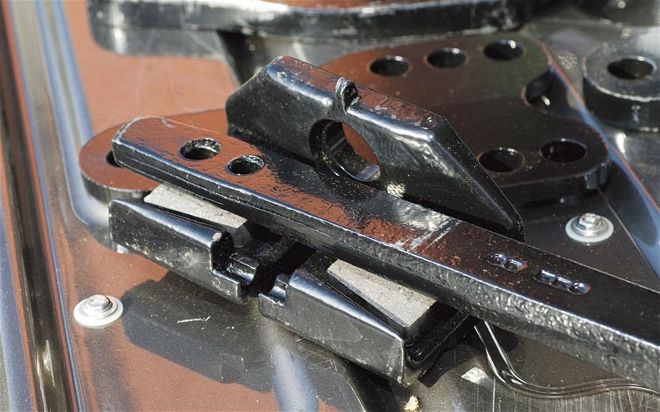
| towing reese SC Series Tow Kit
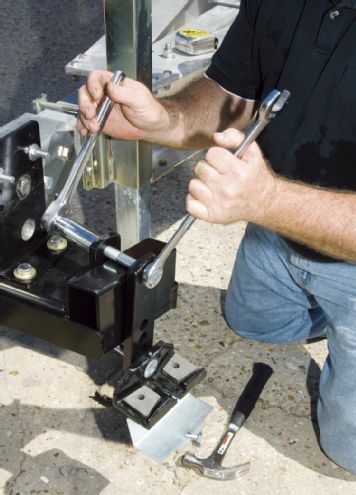
| towing reese SC Series Tow Kit
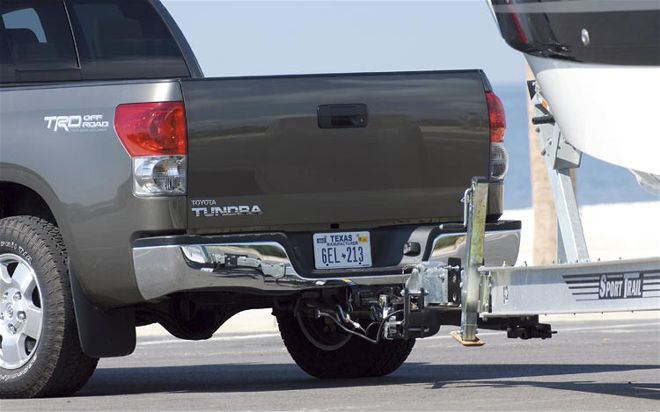
| towing reese SC Series Tow Kit
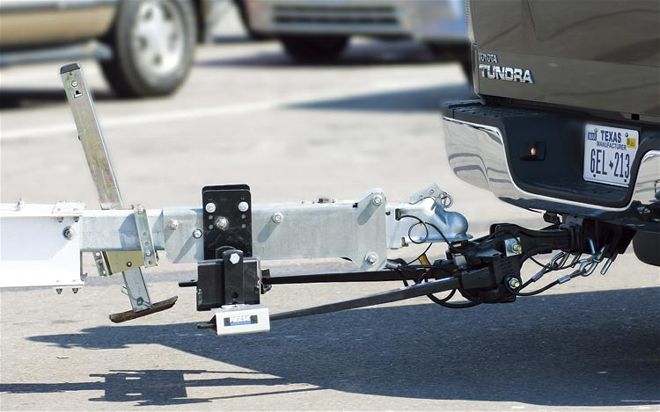
| towing reese SC Series Tow Kit
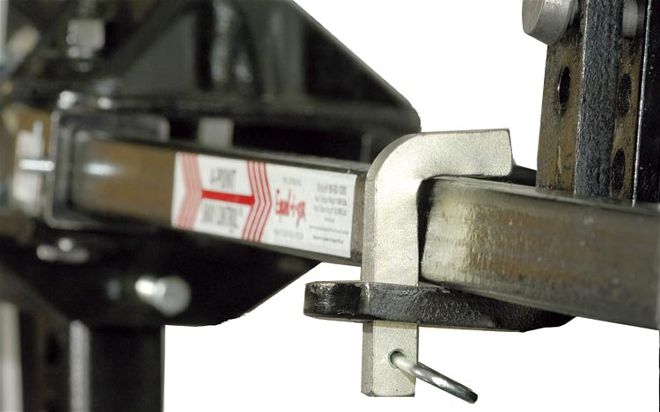
| towing reese SC Series Tow Kit
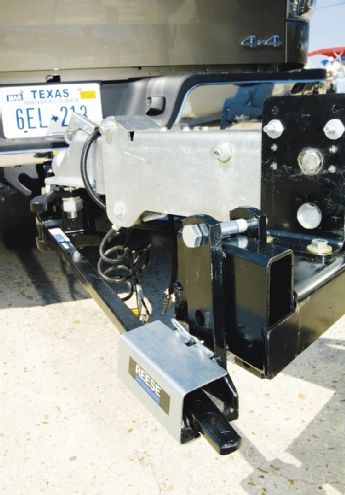
| towing reese SC Series Tow Kit
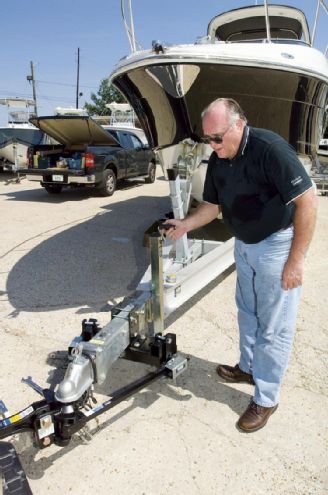
| towing reese SC Series Tow Kit
 | towing 2007 Toyota Tundta With Boat
Cason called his customer, letting him know he was on the way with his new boat. Less than a minute after he finished the call, a big rig blew by in the center lane, then a second big rig came right behind the first.
The trailer behind Cason's truck started a death sway. Less than 30 seconds later, he was crawling out of his pickup on the shoulder while watching the dust settle around the boat, which had come to rest 50 yards away in the center median of the six-lane Interstate. He wasn't hurt, but the boat and trailer weren't as fortunate.
| towing 2007 Toyota Tundta With Boat
Cason called his customer, letting him know he was on the way with his new boat. Less than a minute after he finished the call, a big rig blew by in the center lane, then a second big rig came right behind the first.
The trailer behind Cason's truck started a death sway. Less than 30 seconds later, he was crawling out of his pickup on the shoulder while watching the dust settle around the boat, which had come to rest 50 yards away in the center median of the six-lane Interstate. He wasn't hurt, but the boat and trailer weren't as fortunate.
 | This travel trailer is hooked to the factory receiver and drawbar--the tow vehicle needs a weight-distributing hitch to legally tow this weight travel trailer.
RISK TAKING
| This travel trailer is hooked to the factory receiver and drawbar--the tow vehicle needs a weight-distributing hitch to legally tow this weight travel trailer.
RISK TAKING | Whatever size pickup or SUV you drive, the vehicle has to be properly equipped to tow legally. This driver has an overwide and overweight trailer in tow behind his Dodge Ram.
BIG LIABILITY ISSUE
| Whatever size pickup or SUV you drive, the vehicle has to be properly equipped to tow legally. This driver has an overwide and overweight trailer in tow behind his Dodge Ram.
BIG LIABILITY ISSUE | towing PROPERLY EQUIPPED Manual
As an example, a 2008 Toyota Tundra Double Cab 4x4 is rated to tow a 10,300-pound trailer. But on page 487 of the owner's manual, it clearly states that any trailer weighing more than 2000 pounds requires the use of a sway-control device. For trailers weighing more than 5000 pounds, it's necessary to use a weight-distributing hitch of sufficient capacity.
Ford's F-250/350 Super Dutys require the use of a W-D hitch on trailers weighing more than 5000 pounds as well. Dodge, Chevrolet, GMC, and Nissan pickups and SUVs have similar towing caveats noted in the owner's manuals and on the factory Web sites related to tow ratings.
The reason for such devices is simple: A weight-distributing hitch maintains the vehicle's steering stability and body control when a heavy trailer tries to push the tow vehicle around during cornering, hard braking, through dips in the road, in windy conditions, or any time trailer sway might be induced.
SIMPLE ANSWER
| towing PROPERLY EQUIPPED Manual
As an example, a 2008 Toyota Tundra Double Cab 4x4 is rated to tow a 10,300-pound trailer. But on page 487 of the owner's manual, it clearly states that any trailer weighing more than 2000 pounds requires the use of a sway-control device. For trailers weighing more than 5000 pounds, it's necessary to use a weight-distributing hitch of sufficient capacity.
Ford's F-250/350 Super Dutys require the use of a W-D hitch on trailers weighing more than 5000 pounds as well. Dodge, Chevrolet, GMC, and Nissan pickups and SUVs have similar towing caveats noted in the owner's manuals and on the factory Web sites related to tow ratings.
The reason for such devices is simple: A weight-distributing hitch maintains the vehicle's steering stability and body control when a heavy trailer tries to push the tow vehicle around during cornering, hard braking, through dips in the road, in windy conditions, or any time trailer sway might be induced.
SIMPLE ANSWER | Carefully read your vehicle's owner's manual before towing. It spells out what your vehicle needs to be properly equipped for towing trailers of various weights.
The problem is conventional weight-distributing hitches and sway-control devices interfere with the operation of such braking systems. (W-D hitches that use chains to adjust the bars that do the weight distributing don't always allow the coupler on the trailer to move freely to actuate the braking system.)
However, now there are two weight-distributing hitches designed to work with trailer surge-brake systems: the Equal-i-zer Sway Control Hitch (www.equalizerhitch.com; 800/478-5578) from Progress Manufacturing, and the new Reese SC (www.reeseprod.com; 734/656-3000) from Cequent Towing Products.
Reese's SC, the newest on the market, provides built-in friction sway control and a unique design that allows surge-brake systems to function properly. The kit retails for $560 and is available in 600-, 800-, 1200-, and 1500-pound tongue weight ratings.
ROAD-TEST EVALUATION
| Carefully read your vehicle's owner's manual before towing. It spells out what your vehicle needs to be properly equipped for towing trailers of various weights.
The problem is conventional weight-distributing hitches and sway-control devices interfere with the operation of such braking systems. (W-D hitches that use chains to adjust the bars that do the weight distributing don't always allow the coupler on the trailer to move freely to actuate the braking system.)
However, now there are two weight-distributing hitches designed to work with trailer surge-brake systems: the Equal-i-zer Sway Control Hitch (www.equalizerhitch.com; 800/478-5578) from Progress Manufacturing, and the new Reese SC (www.reeseprod.com; 734/656-3000) from Cequent Towing Products.
Reese's SC, the newest on the market, provides built-in friction sway control and a unique design that allows surge-brake systems to function properly. The kit retails for $560 and is available in 600-, 800-, 1200-, and 1500-pound tongue weight ratings.
ROAD-TEST EVALUATION | towing reese SC Series Tow Kit
| towing reese SC Series Tow Kit
 | towing reese SC Series Tow Kit
| towing reese SC Series Tow Kit
 | towing reese SC Series Tow Kit
| towing reese SC Series Tow Kit
 | towing reese SC Series Tow Kit
| towing reese SC Series Tow Kit
 | towing reese SC Series Tow Kit
| towing reese SC Series Tow Kit
 | towing reese SC Series Tow Kit
| towing reese SC Series Tow Kit
 | towing reese SC Series Tow Kit
| towing reese SC Series Tow Kit
 | towing reese SC Series Tow Kit
| towing reese SC Series Tow Kit